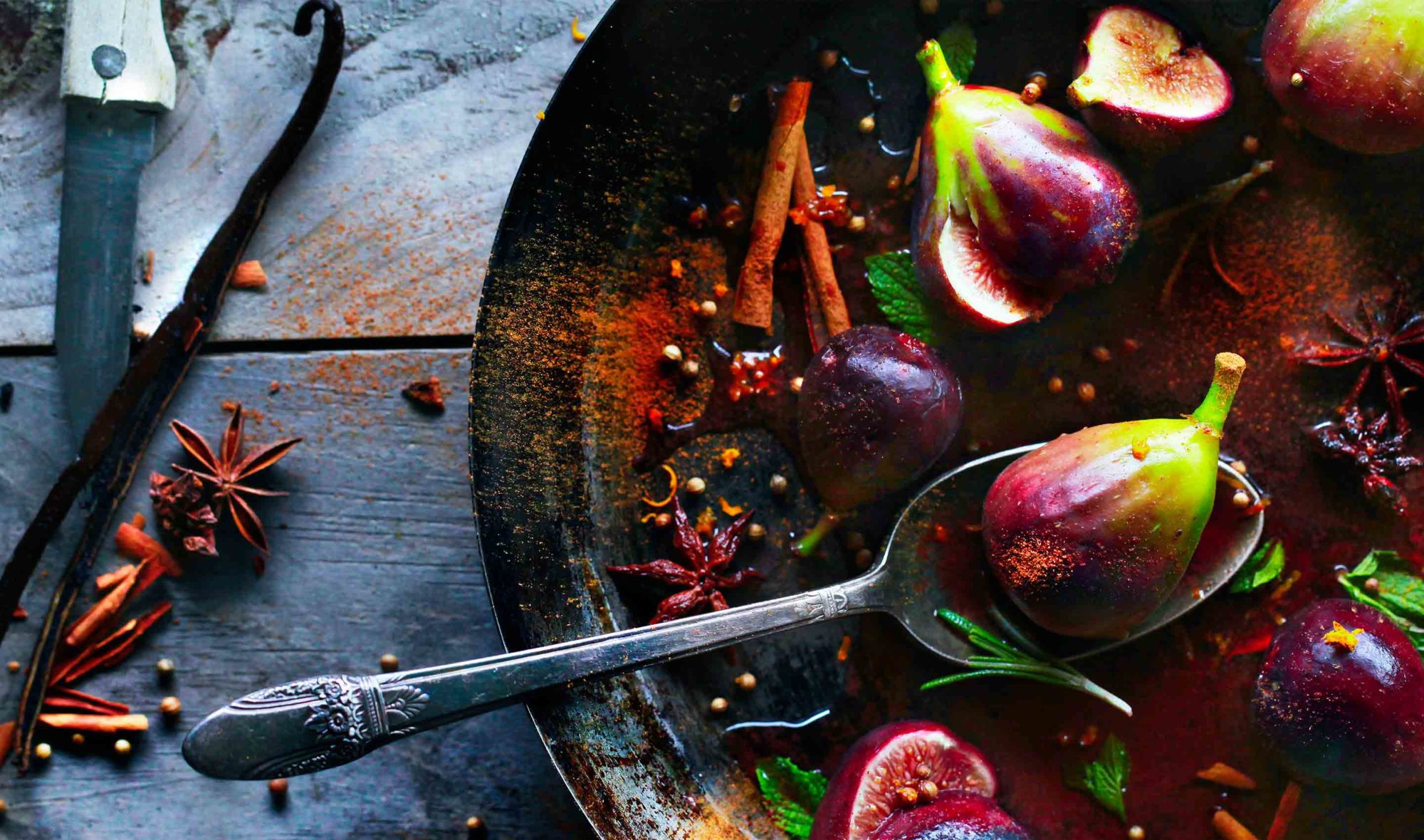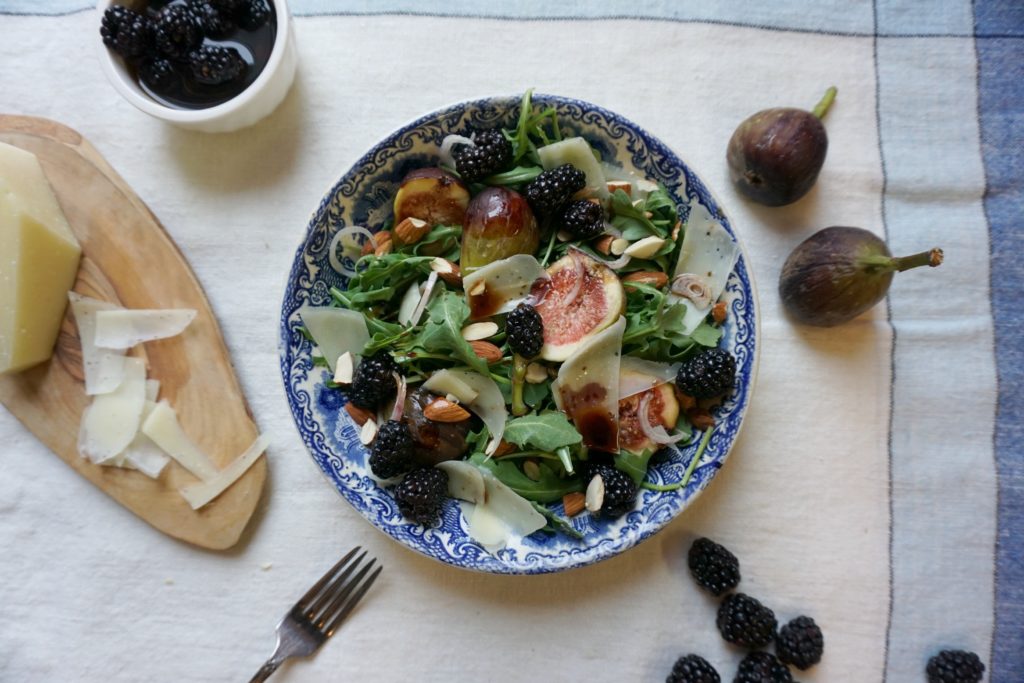
🎁 Holiday Special: SAVE 52% on the Nutrition Coach Starter Package. Limited number remaining.

🎁 Holiday Special: SAVE 52% on the Nutrition Coach Starter Package. Limited # left.

Figs are a type of fruit that can be found fresh or dried. Figs offer rich flavor, fragrant smell, and delicate flesh, which is made up of tiny seeds. They are a good source of fiber, calcium, magnesium and potassium. While they have a slightly savory flavor, figs are fairly sugar dense: one medium fig contains about 8g of sugar to just 37 calories. Figs can be enjoyed fresh, eaten out of hand or added to salads or other cold dishes. Dried figs are often used in baking, or enjoyed as a simple snack. Fresh figs are very delicate, so store them carefully in the fridge and eat them as soon as possible.
The common fig is a species of flowering plant grown for its edible fruit. Technically, the fig is not a fruit but an inverted flower. It is grown in temperate climates, most notably in the Mediterranean.
Many cultivars of figs exist. Black Mission figs are a popular variety. Dried, packaged figs are usually available year-round, but fresh figs come into season throughout early summer and late fall.
Figs typically have a plump, teardrop shape with a rounded bottom and short stem on top. The most common varieties, like Mission figs, are mostly deep purple in color. The inside of the fig is pink and fleshy looking, made up of tiny seeds.
One medium fig (about 50g), contains about 37 calories, 0.4g of protein, 0.2g of fat, 9.6g of carbohydrates, 1.4g of fiber, and 8.1g of sugar.
Figs are rich in fiber, and they also contain plenty of calcium (18mg per one medium fig). Mission figs are dense in a number of minerals and vitamins including magnesium, potassium, and vitamin K.
Fresh figs should feel plump and have a gentle give when pressed. Small cracks or wrinkles are acceptable, but avoid figs that are oozy or have bruised and broken skin. Fresh figs should have a fragrant scent.
Dried figs are usually sold in pre-wrapped packages. Check the expiry date on the package for freshness. If buying bulk, check for mold or discolouration. Dried figs should smell sweet not sour.
Fresh figs are fragile and will spoil quickly. They taste best at room temperature but can be stored in the fridge to extend their lifespan slightly. Generally they should be eaten within two or three days.
Figs can develop mold if they sit too long in moist conditions. To avoid this, keep them in a basket or container with proper air circulation and ensure there is space between each fig.
Dried figs can be kept for up to 6 months, well-wrapped. Keep dried figs in a sealed container or in their original packaging, in a cool dark place.
The entire fig is edible, including its tender skin and the inner flesh, which is filled with tiny edible seeds.
Figs can be eaten out of hand. They are also frequently used in desserts, baked into cookies or tarts, or made into sauces, jams or compotes.
If preparing dried figs, chop with a sharp knife, rinsing the knife occasionally if it gets too sticky.
Tip: To make dried figs easier to slice, put them in the freezer for an hour before preparing them. This works well if chopping a large portion of dried figs for baking.
Fresh figs can be used in savory dishes or snacks. Preparations include grilling or roasting the figs, which caramelizes the fig’s sugars and accentuates its rich, sweet, and savory flavors.
Try adding figs to a cheese board: Add fresh figs, whole or sliced, to a selection of salty cured meats such as prosciutto, cheeses such as brie and blue, a drizzle of honey, and some pistachios and walnuts. The mix of salty, sweet flavours, and creamy and crunchy textures will accentuate the figs’ flavours.

Fresh figs are a luscious delicacy. Here, this sweet, tender fruit is combined with tangy quick-pickled blackberries, asiago cheese, and crunchy almonds, married under a drizzle of balsamic reduction. Swap out the fresh figs for chopped dried figs if that’s all you have access to - the salad is delicious either way.
Prep Time: 25 minutes Cook Time: 15 minutes Yield: 2 servings
For the Quick-Pickled Blackberries:
Add all ingredients to a jar. The liquid should just cover the surface of the blackberries. Close the lid, then give the jar a few gentle shakes to combine the ingredients. Place in the refrigerator and marinate for 6 hours, or overnight. When ready, spoon out blackberries and top over salad as per directions below.
For the Salad and Reduction:
First, make the balsamic reduction: Add one cup of balsamic vinegar to a saucepan over medium-high heat and bring to a good simmer. Allow to simmer for about 10-15 minutes, or until liquid has reduced to about a quarter. Allow to cool until it becomes sticky and syrupy. (You can speed this process up by putting it in the fridge for about 30 minutes.)
Once the blackberries are pickled and the balsamic vinegar is reduced and cooled, assemble the salad: Divide the arugula between two bowls, and then top with cheese, almonds, figs, and a handful of pickled blackberries. Drizzle each bowl with the balsamic reduction, olive oil, and salt and pepper to taste. Serve immediately.
Precision Nutrition’s Encyclopedia of Food expands every single month as we highlight new foods and showcase beautiful food photography. If you’d like to stay up to date, simply click this link. From there, we’ll send you a FREE copy of our recipe book. We’ll also let you know when new and delicious foods are added to the site.
Figs are a type of fruit that can be found fresh or dried. Figs offer rich flavor, fragrant smell, and delicate flesh, which is made up of tiny seeds. They are a good source of fiber, calcium, magnesium and potassium. While they have a slightly savory flavor, figs are fairly sugar dense: one medium fig contains about 8g of sugar to just 37 calories. Figs can be enjoyed fresh, eaten out of hand or added to salads or other cold dishes. Dried figs are often used in baking, or enjoyed as a simple snack. Fresh figs are very delicate, so store them carefully in the fridge and eat them as soon as possible.